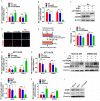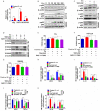Fusobacterium nucleatum Facilitates M2 Macrophage Polarization and Colorectal Carcinoma Progression by Activating TLR4/NF- κ B/S100A9 Cascade
- PMID: 34093546
- PMCID: PMC8176789
- DOI: 10.3389/fimmu.2021.658681
Fusobacterium nucleatum Facilitates M2 Macrophage Polarization and Colorectal Carcinoma Progression by Activating TLR4/NF- κ B/S100A9 Cascade
Abstract
Fusobacterium nucleatum (Fn) has been considered as a significant contributor in promoting colorectal carcinoma (CRC) development by suppressing host anti-tumor immunity. Recent studies demonstrated that the aggregation of M2 macrophage (Mφ) was involved in CRC progress driven by Fn infection. However, the underlying molecular mechanisms are poorly characterized. Here, we investigated the role of Fn in Mφ polarization as well as its effect on CRC malignancy. Fn infection facilitated differentiation of Mφ into the M2-like Mφ phenotype by in vitro study. Histological observation from Fn-positive CRC tissues confirmed the abundance of tumor-infiltrating M2-like Mφ. Fn-induced M2-like Mφ polarization was weakened once inhibiting a highly expressed damage-associated molecular pattern (DAMP) molecule S100A9 mainly derived from Fn-challenged Mφ and CRC cells. In addition, Fn-challenged M2-like Mφ conferred CRC cells a more malignant phenotype, showing stronger proliferation and migration characteristics in vitro and significantly enhanced tumor growth in vivo, all of which were partially inhibited when S100A9 was lost. Mechanistic studies further demonstrated that activation of TLR4/NF-κB signaling pathway mediated Fn-induced S100A9 expression and subsequent M2-like Mφ activation. Collectively, these findings indicate that elevated S100A9 in Fn-infected CRC microenvironment participates in M2-like Mφ polarization, thereby facilitating CRC malignancy. Furthermore, targeting TLR4/NF-κB/S100A9 cascade may serve as promising immunotherapeutic strategy for Fn-associated CRC.
Keywords: Fusobacterium nucleatum; S100A9; TLR4; colorectal carcinoma; macrophage.
Copyright © 2021 Hu, Liu, Kong, Wu, Peng, Zhang, Zhou and Duan.
Conflict of interest statement
The authors declare that the research was conducted in the absence of any commercial or financial relationships that could be construed as a potential conflict of interest.
Figures







Similar articles
-
Fusobacterium nucleatum promotes M2 polarization of macrophages in the microenvironment of colorectal tumours via a TLR4-dependent mechanism.Cancer Immunol Immunother. 2018 Oct;67(10):1635-1646. doi: 10.1007/s00262-018-2233-x. Epub 2018 Aug 18. Cancer Immunol Immunother. 2018. PMID: 30121899 Free PMC article.
-
The role of Fusobacterium nucleatum in macrophage M2 polarization and NF-κB pathway activation in colorectal cancer.Front Immunol. 2025 Apr 3;16:1549564. doi: 10.3389/fimmu.2025.1549564. eCollection 2025. Front Immunol. 2025. PMID: 40248690 Free PMC article.
-
Fusobacterium Nucleatum Promotes Microsatellite Instability in Colorectal Carcinoma Through Up-regulation of miRNA-155-5p-Targeted Inhibition of MSH6 via the TLR4/NF-κB Signaling Pathway.Adv Biol (Weinh). 2024 Dec;8(12):e2400293. doi: 10.1002/adbi.202400293. Epub 2024 Sep 27. Adv Biol (Weinh). 2024. PMID: 39334517
-
Association of Fusobacterium nucleatum with immunity and molecular alterations in colorectal cancer.World J Gastroenterol. 2016 Jan 14;22(2):557-66. doi: 10.3748/wjg.v22.i2.557. World J Gastroenterol. 2016. PMID: 26811607 Free PMC article. Review.
-
Fusobacterium nucleatum and colorectal cancer: From phenomenon to mechanism.Front Cell Infect Microbiol. 2022 Nov 29;12:1020583. doi: 10.3389/fcimb.2022.1020583. eCollection 2022. Front Cell Infect Microbiol. 2022. PMID: 36523635 Free PMC article. Review.
Cited by
-
Interleukin-22 protects from endotoxemia by inducing suppressive F4/80+Ly6GhiLy6Chi cells population.BMC Immunol. 2022 Sep 19;23(1):45. doi: 10.1186/s12865-022-00511-6. BMC Immunol. 2022. PMID: 36123595 Free PMC article.
-
Contribution of immune cells to bone metastasis pathogenesis.Front Endocrinol (Lausanne). 2022 Sep 29;13:1019864. doi: 10.3389/fendo.2022.1019864. eCollection 2022. Front Endocrinol (Lausanne). 2022. PMID: 36246916 Free PMC article. Review.
-
Fusobacterium nucleatum: a novel immune modulator in breast cancer?Expert Rev Mol Med. 2023 Apr 3;25:e15. doi: 10.1017/erm.2023.9. Expert Rev Mol Med. 2023. PMID: 37009688 Free PMC article. Review.
-
Integrated oral-gut microbiota therapy: a novel perspective on preventing bacterial translocation for systemic disease management.Front Cell Infect Microbiol. 2025 Jul 28;15:1641816. doi: 10.3389/fcimb.2025.1641816. eCollection 2025. Front Cell Infect Microbiol. 2025. PMID: 40792109 Free PMC article. Review.
-
The Role of Fusobacterium nucleatum in Colorectal Cancer Cell Proliferation and Migration.Cancers (Basel). 2022 Oct 30;14(21):5350. doi: 10.3390/cancers14215350. Cancers (Basel). 2022. PMID: 36358769 Free PMC article. Review.
References
-
- Eser S, Chang J, Charalambous H, Silverman B, Demetriou A, Yakut C, et al. . Incidence Patterns of Colorectal Cancers in Four Countries of the Middle East Cancer Consortium (Cyprus, Jordan, Israel, and Izmir, Turkey) Compared With Those in the United States Surveillance, Epidemiology, and End Results Program. Turk J Gastroenterol (2018) 29(1):36–44. 10.5152/tjg.2018.17263 - DOI - PMC - PubMed
Publication types
MeSH terms
Substances
LinkOut - more resources
Full Text Sources
Other Literature Sources
Medical
Miscellaneous

